My visit to the temples at Badoli in November last year turned out to be a memorable one.
First, my camera battery died on me suddenly and without warning. Then my iPad camera stopped functioning, and if that weren’t enough my temperamental cell phone decided to be on its worst behaviour. Talk about bad luck coming in threes ! The result? I have a total of 28 photos from all these 3 devices of the visit to the temples at Badoli.
Second, the temples at Badoli itself for there were many little surprises and discoveries waiting for me. Since I hadn’t read up or researched on the temples prior to my visit, everything about the place was unexpected. Of course, I read the information board placed at the entrance for some guidance, but we all know how detailed those are ! For example, the opening lines of the information board say that the:
Badoli Group is a cluster of nine temples that is stylistically dated to circa 10th-11th century AD [sic]. These temples are dedicated to Shiva, Vishnu, Ganesha, Mahisasuramardini and Mataji, etc. [emphasis mine]
It then goes on to talk about the main Shiva temple there — the Ghateshwara Mahadeva Temple. As I was to find out, and you will too when you read the rest of the post, some of the most interesting and significant features of the Badoli temples were not mentioned in the board at all, unless we assume that the word ‘etc.’ in the lines above was meant to encompass everything else. 😛

The Badoli temples are on the banks of the river Chambal near Rawatbhata town, about 50 km from Kota. These are some of the earliest known structural temples in Rajasthan and are believed to have been built during the reign of the Gurjara Pratihara Empire in the region.
In the past, the temples would have been surrounded by dense forests; today, the forests are still around though they have thinned. The temples themselves are now in an elaborately landscaped setting with well-defined paths leading to the various temples. The temple complex is a popular picnic spot, if the presence of picnickers on the lawns was any indication. Our group, too, had a picnic lunch there before we began our exploration of the temples. Let me show them to you the way I saw them at Badoli.
The first temples a visitor will see are two small temples with broken shikharas. One of the temples is dedicated to Shiva and set in the midst of what would have been a stepped water tank, if it had been filled with water. There wasn’t any water in it when we were there (and my guess water never fills up there anymore), so the temple looked like it a sunken temple instead. Though the age of the temples are not known, I would guess that these were built after the main temple, the Ghateshwara Mahadeva was built.
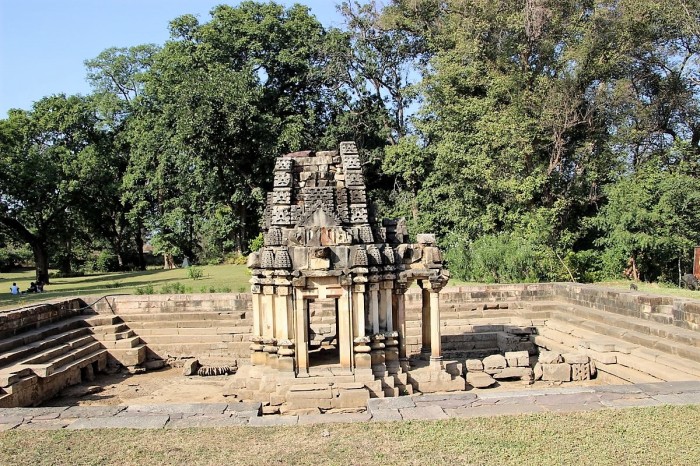
The Ghateshwara Mahadeva is not just the oldest, but also the largest temple in Badoli. Built in the early parts of the 10th century CE, the temple is supposed to have got its name from the rather unusually shaped lingam installed there — a ghata or a pot-shaped lingam. Both the exterior and interiors of the temple, including the ceiling, are exquisitely carved. There is an impressive Gajasamharamurti — one of the best I have come across — in an external niche. One of the most impressive features of this temple is its spire, whose carvings look like a geometric textile weave.
The temple, which is believed to have been under continuous worship from the time it was built, has an ardha mandapa with octagonal pillars. These pillars have sculptures (or the remains) of surasundaris on the lower halves in very graceful poses. A ranga mandapa or a shringara chauri is located just opposite the entrance to the Ghateshwar Mahadev. A later addition to the Badoli Complex, maybe 12th or 13th century, this one too is carved with forms of Shiva as well as dancing figures.

The temples dedicated to Ganesha and Mahisasuramardini are located next to the main temple and are much smaller in size with only a porch and the garbha griha. Both temples are dated to having been built in late 10th century CE. While the state of the idols installed in the sanctum saddened me deeply, their size is surprising. How magnificent they would have been when whole and under worship.
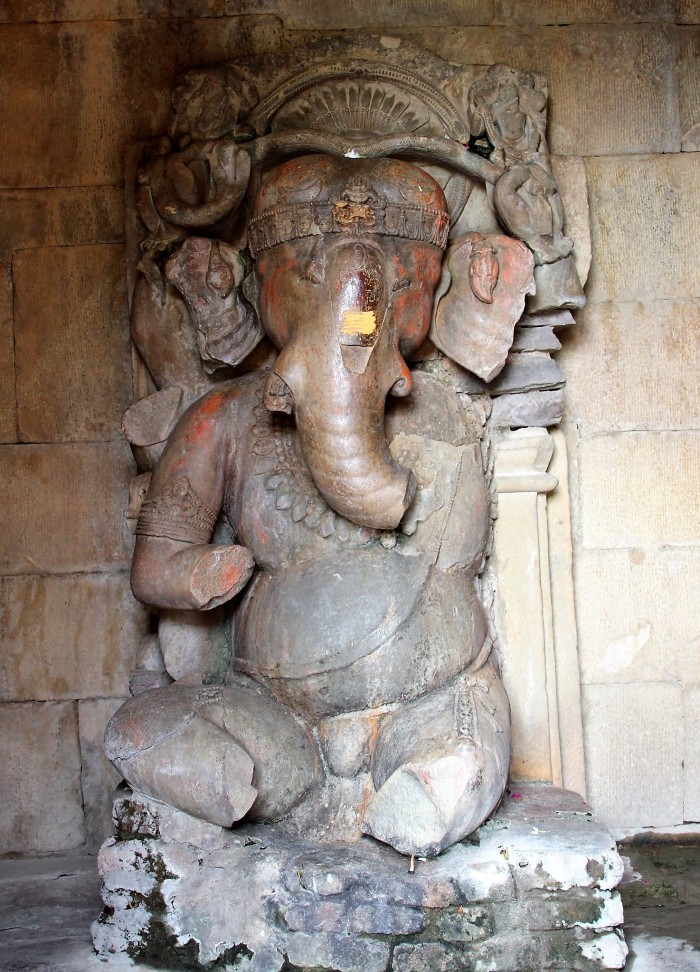

The Vamana temple is, perhaps, the smallest of all the temples in Badoli and has a flat roof, instead of a spire. Whether the spire broke in the past or was never built is something we can only speculate. The Vamana idol, which is about 2-3 ft tall, is quite elaborately carved and though it has suffered the least damage, as compared to the other idols in Badoli, it is by no means whole as you can see in the photograph below.

I almost didn’t see the Sadashiva Temple at Badoli I had wandered off to explore the grounds and somehow missed out on visiting this temple, which was a little surprising as all the temples are grouped fairly close together. It was only when I was going in for a second look at all the temples to see if I had overlooked any detail that I came to the Sadashiva Temple and stopped short in awe.
The three faces of the Sadashiva idol covers one full wall in the sanctum from edge to edge and from floor to the ceiling. After the one at Elephanta, this is the largest Sadashiva that I have seen. While the central face is completely destroyed with only the outline remaining, the two faces on the sides have some discernible features left. Aghora (left) is particularly fearsome; while the feminine features of the face on the right as well as the elaborate jatamukuta are clearly visible.




The temples in the Badoli Complex were not the only ones to yield surprises; the grounds, which are littered with remains of sculptures and other temple parts. Without doubt, the most impressive find was the remains of an elaborately carved door of which only the lintel and parts of the side survives. This would have been the doorway for the garbha griha in one of the temples at Badoli. But which temple? I don’t know.
Even a casual look at the door will reveal that this would have been in a Shiva temple. From matrikas to navagrahas to people worshiping the lingam, do music and dance, to Brahma and Vishnu on either side of the door to Shiva in the centre — all this indicates that this was at a temple dedicated to Shiva. The Shiva on the door is most probably Lakulisa, which makes me wonder if this was part of the doorway at the Sadashiva Temple, since both are associated with the Saiva Siddhanta or Pashupata Shaivism traditions.
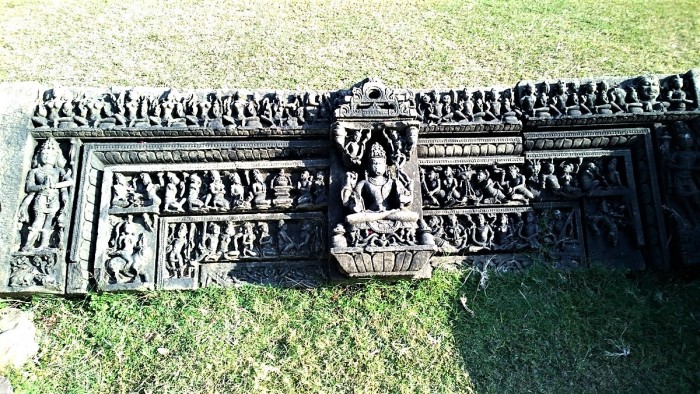
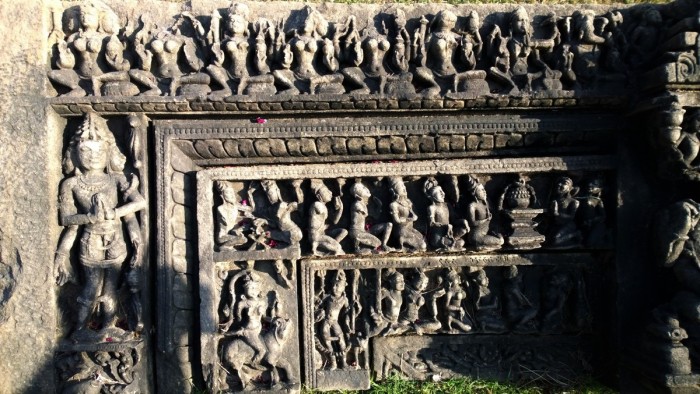
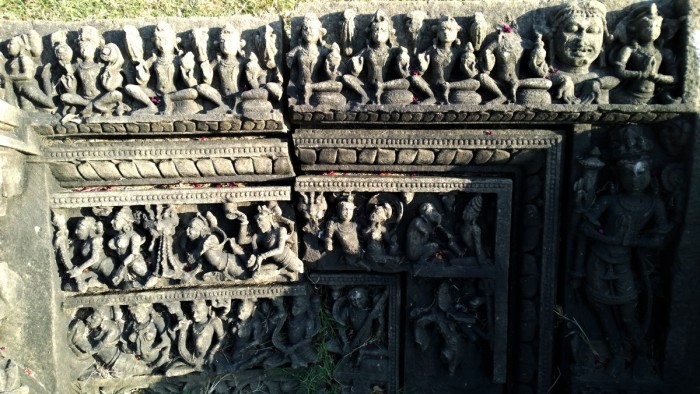
One of the biggest surprises that the Badoli temple complex revealed was the presence of a small stepwell, which is believed to be of the same age as that of temple complex itself, that is 11th-12th century CE. While the water is a virulent green today and cannot be used for any purpose, in the past waters from this stepwell would have been not only used for all rituals in the various temples, but also served the needs of those who lived and served in the temple complex.
Near the stepwell is an open air shrine on a high platform with a vermilion covered stone that appears featureless and formless, but is not. Was this the Mataji temple, mentioned in the information board? Or was it Hanuman? Or someone else? I can’t be sure, but the shrine looks like it is a more recent addition to the temple complex built on the plinth of an earlier, but now destroyed, temple.


If you recall, there was a Vishnu Temple mentioned in the information board at Badoli. For the longest time, I thought that the Vamana Temple was the Vishnu temple mentioned. That is, till I started looking for some background information on the Badoli Temples in preparation for writing this post. I found that there used to be Vishnu Temple with an idol of the Sheshshayi form of Vishnu in the sanctum. The temple is destroyed, but not the idol, which is currently located in the Government Museum at Kota !
This kind of half information or even misleading information is not unique to Badoli; I’ve read too many of them to believe that they are exceptions. Good information board(s) have to maintain a balance of revealing just enough information to piqué the interest of the average visitor, and not be too wordy. Such information boards are rare; most that I have come across are quite dry or obtuse enough to put off even the most determined visitor like me. Or worse, misrepresent or omit important information. I have learnt to read such information with an open mind and eyes too.
These little hiccups and my camera woes aside, the afternoon in Badoli was great fun — it was my kind of place where I could potter around and I’m sure if someone was observing me, they would have seen me flitting from temple to temple, sculpture to sculpture. I left Badoli happy and contented and for a change didn’t dwell on the questions that normally come up after such a visit. It is not that the questions were not there; I just postponed the reflection to a later time.
And there I was moving towards the exit with a last glance at the temples, when our guide Kukkiji (more about him in forthcoming posts) came up to me and said that he wanted to show me something. He said that since I was interested in “sculptures and all things old” (his words, not mine!), I just had to see it. So I followed him as he went off the main path and through some bushes to this magnificent sculpture of a very life-like naga.
Almost 4 ft tall, this naga would have come from one of the temples here or could even have been part of a tree or water shrine nearby. In the absence of any information we can only speculate on its origin, its age and the stories it would have attached to it. This was the perfect and gorgeous end to the visit to the Badoli temples.
Agree? 🙂
Disclaimer: This part of my Hadoti Trip was done with One Life to Travel, and it was NOT a free, sponsored or discounted trip.
The Hadoti Trip Series: Dear Hadoti | Discovering Jhalawar | The painted rooms of Garh Mahal of Jhalawar | Bhawani Natyashala: The Opera House of Jhalawar | An evening in Jhalrapatan | The Buddhist rock-cut caves at Kolvi | The Gagron Fort at Jhalawar | An impact crater, a temple ruin and some discoveries | A fun evening in Kota | A safari on the Chambal River | The painted rooms of the Kota Garh Palace | The Shiva temples of Bijolia | The temples at Badoli | That and this in Bundi | The painted rooms of Bundi Palace | The stepwells of Bundi | The Hadoti Trip Planner |
Join me on Twitter, Facebook and Instagram as I explore the world around me and share “My Favourite Things” with you.





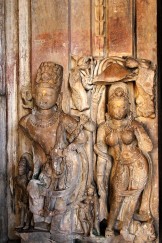




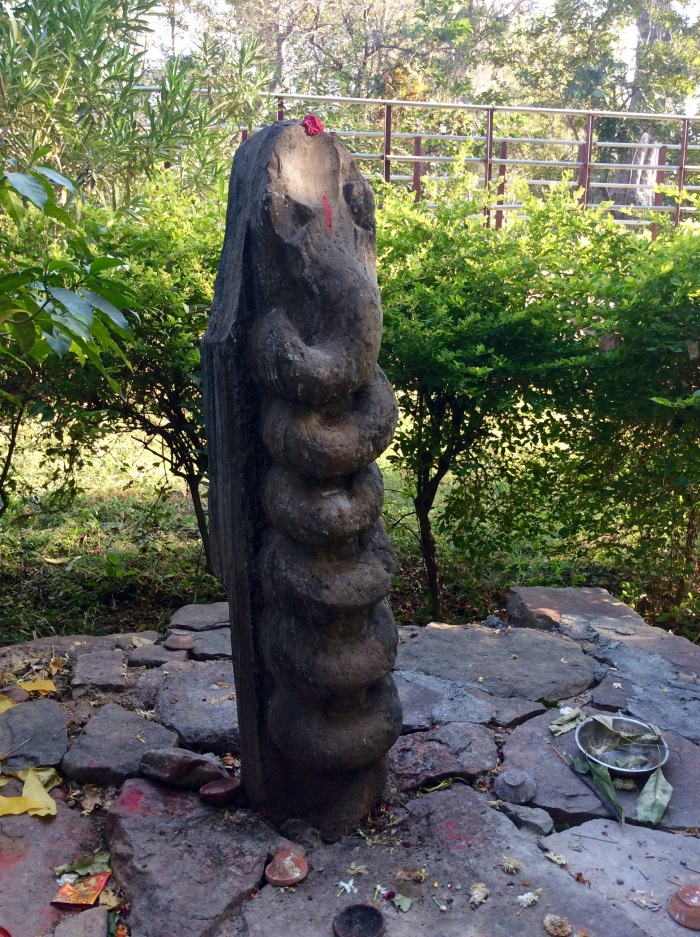

You are incorrigible Sudha gee. I am still laughing at ’’stylistically dated to circa 10th-11th century AD [sic)’’. The photo essay is still amazing in-spite of the fact that camera battery and iPad’s temporary death. Must visit soon…
LikeLiked by 1 person
Thank you, Nutsure. 🙂 The Badoli Temples are only an hour from Kota and if you are ever in the area, you must visit them.
LikeLike
I have read your blog. it is very interesting and informative.
LikeLiked by 1 person
Thank you very much for the appreciation, Bhandurga. 🙂
LikeLike
Thank you for posting such an blog. I was not knowing that such an ancient temple exist in Bardoli area of Gujarat. There are many temple which exist in Bardoli. The architecture of the temple is very beautiful. The images that you have posted in this blog of temple,god and goddess are very beautiful.
Once again thank you very much.
LikeLike
really nice your all images and artice in reality i really don’t know about badoli thanks for sharing these kind of information about badoli once in life time i’ll surely go there thanks a lot and keep it up…….!
LikeLike